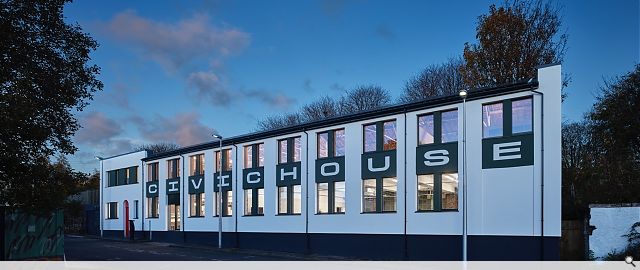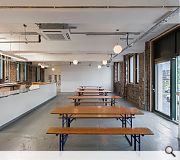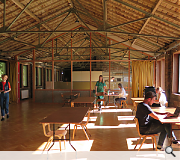Civic House
Civic House, originally constructed in 1920 as a printing press, is now a workspace, venue and canteen that supports a community of people working across social, cultural and green enterprise. Funded by the Climate Challenge Fund and Scottish Power Energy Network’s (SPEN) Green Economic Fund, Collective Architecture was commissioned by Agile City to undertake the refurbishment and thermal upgrade of this early 20th century industrial warehouse located in the north of Glasgow. The core principle of the project was to create a leading example that demonstrated carbon reduction innovation as Scotland’s first retrofit ‘PassivWarehaus’. In 2017, Collective Architecture was appointed by Agile City to facilitate an energy analysis and feasibility study to define the scope for retrofitting the existing building.
Following a number of site visits and discussions with the client to identify key issues, the energy balance tool ‘Passive House Planning Package’ (PHPP) was used to verify space the heating demand before and after retrofit. Further to the completion of the study, it was agreed with client that a step-by-step retrofit approach and phased plan were to be considered in order to tie in with the client’s available funding. Collective Architecture worked collaboratively with the client from the outstart to find cost effective ways of retrofitting the building to high levels of performance, in conjunction with funding applications. This has been a learning process for both parties. The client was keen to make the building an exemplar and this extended to becoming involved with the application of the airtightness tape themselves, in order to save on costs. The client was very hands on and a key part of pushing the potential for the building to be retrofitted to target EnerPHit standards.
The community activities of the building are supported by the building’s sustainable development - which saw the building being deeply retrofitted, with the installation of a full Solar PV array on the roof - reducing heating demand to an absolute minimum via high specification insulation and heat-recovery systems, while also generating more electricity than it consumes over an annual basis. In essence the building can become one of many mini power stations of the future. Now complete, the project aims to deliver a public learning programme that explores sustainability and inclusive city development to increase knowledge, develop new skills and drive local behavioural change. As a community-based workspace, the project aims to demonstrate that small actions can generate large-scale impact.
Back to Retail/Commercial/Industrial
- Buildings Archive 2024
- Buildings Archive 2023
- Buildings Archive 2022
- Buildings Archive 2021
- Buildings Archive 2020
- Buildings Archive 2019
- Buildings Archive 2018
- Buildings Archive 2017
- Buildings Archive 2016
- Buildings Archive 2015
- Buildings Archive 2014
- Buildings Archive 2013
- Buildings Archive 2012
- Buildings Archive 2011
- Buildings Archive 2010
- Buildings Archive 2009
- Buildings Archive 2008
- Buildings Archive 2007
- Buildings Archive 2006





